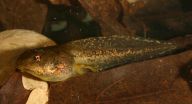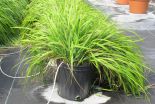(Press-News.org) Millions of tons of road salt are applied to streets and highways across the United States each winter to melt ice and snow and make travel safer, but the effects of salt on wildlife are poorly understood.
A new study by biologists from Case Western Reserve University suggests exposure to road salt, as it runs off into ponds and wetlands where it can concentrate--especially during March and early April, when frogs are breeding--may increase the size of wood frogs, but also shorten their lives.
Wood frog tadpoles exposed to road salt grew larger and turned into larger frogs at metamorphosis than those raised without being subjected to the contaminant, researchers found.
But, contrary to expectations that larger body mass is associated with greater survival, frogs exposed to salt as tadpoles had a higher mortality rate as juveniles.
"This study really shows that you need to look across multiple life stages to get a good look at what environmental pollutants are doing," said Kacey Dananay, a Case Western Reserve PhD student who led two experiments in the study.
Dananay worked with Biology Professor Michael Benard, Katherine Krynak, who recently earned a PhD at Case Western Reserve, and Tim Krynak, project manager for Natural Resources at Cleveland Metroparks. Their findings are published online in the journal Environmental Toxicology and Chemistry.
"Most studies have shown that exposure to salt reduces the size of tadpoles," Benard said, but those were done in labs, where the tadpoles are fed regularly and the climate is controlled.
The researchers wanted to see what happens in the frogs' natural habitat.
Benard, Tim Krynak, Katherine Krynak, and several field assistants sampled public and private lands, including many sites in Cleveland Metroparks, to determine where amphibians breed naturally in Northeast Ohio. They tested whether the frog's presence, abundance, size or stage of developmental were associated with road salt contamination at 30 wetlands.
They dipped nets into the water for a certain period of time and collected up to 30 specimens, then measured for growth and developmental stage. The researchers measured the water's conductivity, which provides an estimate of road salt contamination, and overhead forest canopy, which is associated with reduced larval growth and development.
Using those variables and distance from the nearest road and rate at which tadpoles were caught, they performed statistical analyses. They found wood frog tadpoles were less abundant in wetlands with higher salt concentrations but had higher body mass.
Intrigued by these correlations, Dananay and Benard then ran two experiments in artificial ponds at the university's Squire Valleevue and Valley Ridge Farms. To test whether salt affects larval wood frog development, they added road salt in different concentrations: none, 100, 500 and 900 milligrams per liter--concentrations they'd found in the survey.
Egg masses were collected and, four and five days after hatching, the tadpoles were placed in the ponds.
The salt appeared to restrict the growth of zooplankton, which, like tadpoles, feed on pond algae, the scientists found. This likely allowed algae to grow more abundant, providing more food and resulting in larger tadpoles.
In a second experiment, half the tadpoles were raised in clean water and half in water with 500 milligrams of salt per liter. The second group grew larger and at metamorphosis transformed into larger frogs.
Juvenile frogs from both groups were randomly assigned to pens and placed either in pairs or groups of five in a total of 20 enclosures. Survival rate in the high-concentration groups was the same for juveniles that had been exposed to salt as tadpoles and those that had not. Among the juveniles in low-concentration pens, those that had been exposed to salt had a significantly lower survival rate compared to those that had not.
"We would predict the frogs that are larger at metamorphosis would do better--larger body mass is usually an indication that they are more fit," Dananay said. "Maybe they're more susceptible to disease or there's a physiological change we can't see."
Early salt exposure may have also altered how juvenile frogs allocate energy for growth and metabolism in terrestrial environments that vary in the amount of food available per frog, the researchers suggest.
Dananay and Benard are planning follow-up studies, placing tadpoles and frogs in more complicated environments as well as investigating multiple effects that may carry-over from tadpole to juvenile frog. They are also planning to study the physiological effects of salt exposure.
INFORMATION:
In addition to melting icecaps and imperiled wildlife, a significant concern among scientists is that higher Arctic temperatures brought about by climate change could result in the release of massive amounts of carbon locked in the region's frozen soil in the form of carbon dioxide and methane. Arctic permafrost is estimated to contain about a trillion tons of carbon, which would potentially accelerate global warming. Carbon emissions in the form of methane have been of particular concern because on a 100-year scale methane is about 25-times more potent than carbon dioxide ...
Magnetism in nanoscale layers only a few tens of atoms thick is one of the foundations of the big data revolution - for example, all the information we download from the internet is stored magnetically on hard disks in server farms dotted across the World. Recent work by a team of scientists working in Singapore, The Netherlands, USA and Ireland, published on 14 August 2015 in the prestigious journal, Science, has uncovered a new twist to the story of thin-film magnetism.
The team from the National University of Singapore (NUS) - Mr Li Changjian, a graduate student from ...
Bilingual children pose unique challenges for clinicians, and, until recently, there was little research on young bilinguals to guide clinical practice. In the past decade, however, research on bilingual development has burgeoned, and the scientific literature now supports several conclusions that should help clinicians as they assess bilingual children and advise their parents.
In an article recently published in Seminars in Speech and Language, Erika Hoff, Ph.D., a professor of psychology in the Charles E. Schmidt College of Science at Florida Atlantic University, ...
ANN ARBOR, Mich. - One of the most common complaints about hospitals is the noise. Patients complain that they can't sleep soundly in the environment of multiple monitors, paging systems, wheelchairs and gurneys, and carts that squeak.
Ongoing efforts at the University of Michigan Health System are making the hospital quieter, and the hospital has tested sound panels designed to dial down noise.
During a pilot study, strategically placed sound acoustic panels helped diffuse sound in the hallways around patient rooms. The modest 3-4 sound decibel drop is recognizable ...
When researchers dream about electronics of the future, they more or less dream of pouring liquids into a beaker, stirring them together and decanting a computer out onto the table. This field of research is known as self-assembling molecular electronics. But, getting chemical substances to self-assemble into electronic components is just as complicated as it sounds. Now, a group of researchers has published their breakthrough within the field. The group consists of first-year nanoscience students from the University of Copenhagen.
Thomas Just Sørensen, an associate ...
This news release is available in German. Two growth-promoting groups of substances, or phytohormones, the gibberellins and the brassinosteroids, are used independently of each other for the breeding and production of crop plants. A team of scientists at Technical University of Munich (TUM) has now discovered that the two act in concert - without brassinosteroids, a plant is unable to produce gibberellins.
For their current investigations, a research group at the Technical University of Munich, supported by scientists from the Helmholtz Zentrum Munich and the TU Braunschweig ...
ANN ARBOR, Mich. -- With every breath you take, microbes have a chance of making it into your lungs. But what happens when they get there? And why do dangerous lung infections like pneumonia happen in some people, but not others?
Researchers at the University of Michigan Medical School have started to answer these questions by studying the microbiome of the lungs - the community of microscopic organisms are in constant contact with our respiratory system.
By studying these bacterial communities, and how they change in illness, they hope to pave the way for new ways ...
Troubling questions about multiracial congregations' potential to address racial inequality are raised by a new national study done by researchers at Baylor University, the University of Southern California and the University of Chicago.
The study -- "United by Faith? Race/Ethnicity, Congregational Diversity, and Explanations of Racial Inequality" -- is published in the journal Sociology of Religion.
"We find little evidence that multiracial congregations promote progressive racial views among attendees of any race or ethnicity," the researchers wrote. Views of minorities ...
BOSTON, Aug. 17, 2015 --Native North Americans have long adorned themselves and their homes with fragrant sweetgrass (Hierochloe odorata), a native plant used in traditional medicine, to repel biting insects, and mosquitoes in particular. Now, researchers report that they have identified the compounds in sweetgrass that keep these bugs at bay.
The team will describe their approach in one of more than 9,000 presentations at the 250th National Meeting & Exposition of the American Chemical Society (ACS), the world's largest scientific society, taking place here through Thursday.
Mosquitoes ...
BOSTON, Aug. 17, 2015 -- Hand-written letters and printed photos seem quaint in today's digital age. But there's one thing that traditional media have over hard drives: longevity. To address this modern shortcoming, scientists are turning to DNA to save unprecedented amounts of digital data for posterity. One team has demonstrated that DNA they encapsulated can preserve information for at least 2,000 years, and they're now working on a filing system to make it easier to navigate.
The researchers present their work today at the 250th National Meeting & Exposition of the ...





